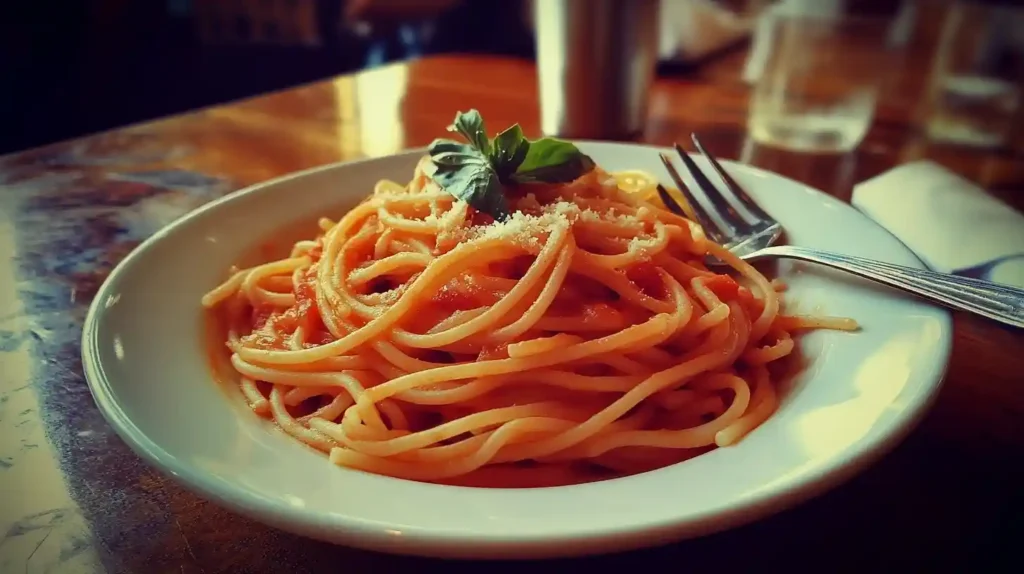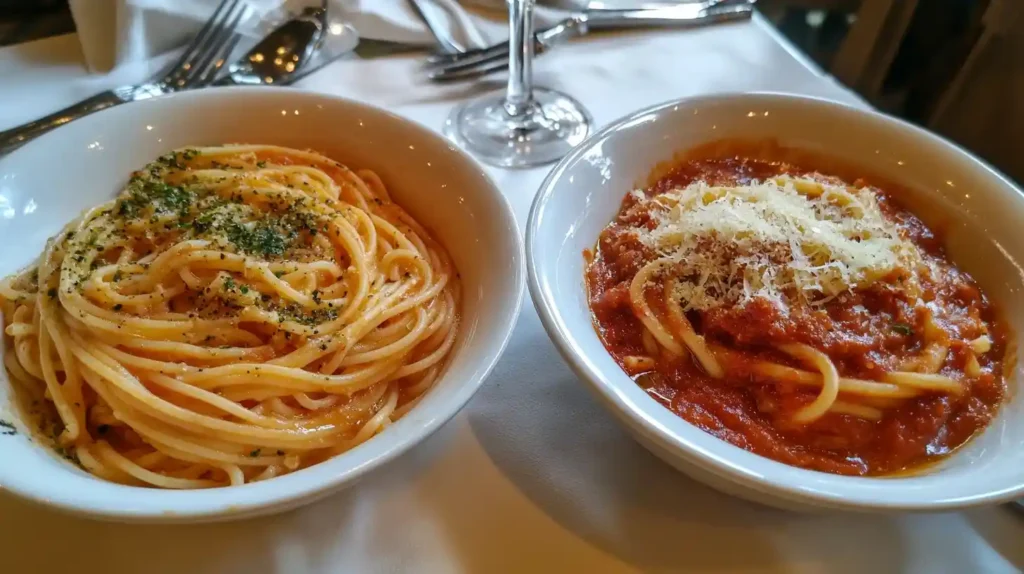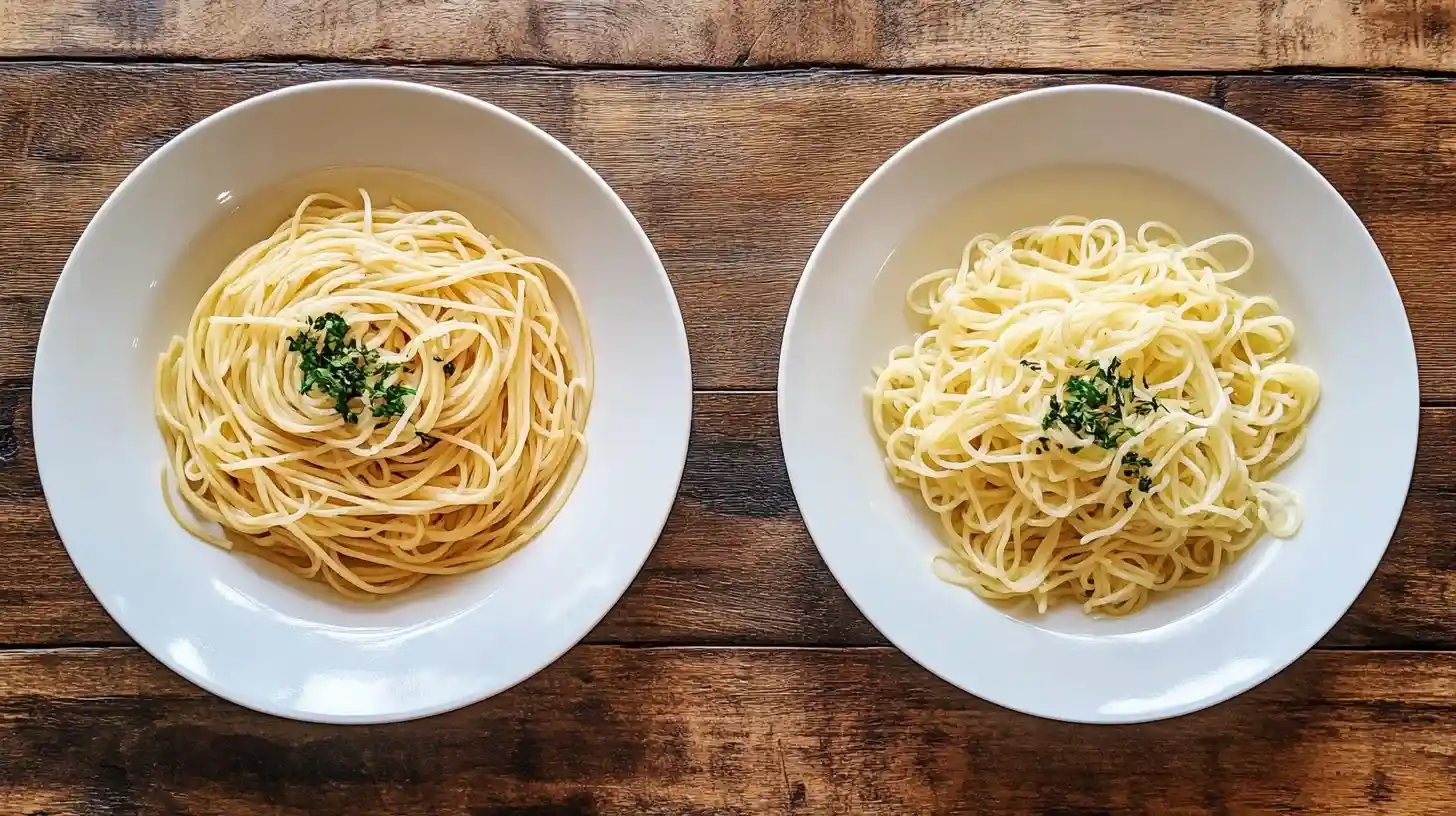Pasta is loved around the world. It is a key part of Italian cuisine. Spaghetti and spaghettini are two similar types of pasta. But how are they different? Knowing the difference can help you cook better meals. You can pair each with the best sauce for a delicious dish.
Table of contents
The Origins of Spaghetti and Spaghettini
Pasta is a food with a long history. Among the various types, spaghetti is one of the most well-known. Its name comes from the Italian word “spago,” which means string. This makes sense because spaghetti looks like long, thick strings. It is easy to cook, and it pairs well with rich sauces like Bolognese or marinara.

In contrast, spaghettini is a finer, thinner version of spaghetti.. It is also called “little spaghetti.” It was created for dishes that need a lighter touch. For instance, spaghettini pairs well with seafood sauces or olive oil-based dishes.
Both types of pasta are a big part of Italian culture. Over time, they became popular all over the world. In fact, both are used in different ways to make meals special. You can learn more about their history in this guide on pasta shapes.
How Spaghetti and Spaghettini Are Different
Spaghetti and spaghettini may appear similar, but they have distinct differences. These differences are important when choosing the right one for your recipe. Let’s explore their unique features.
Size and Shape
While both are long, thin pasta types, the primary distinction lies in their thickness:
- Spaghetti: Thicker, sturdier, and perfect for robust sauces like Bolognese and Alfredo.
- Spaghettini: Thinner, lighter, and ideal for delicate dishes such as seafood-based sauces or garlic and olive oil.
Cooking Time
Another key difference is cooking time.
- Spaghetti takes about 9–12 minutes to cook to an al dente texture.
- Spaghettini cooks faster, usually in 6–8 minutes.
The thickness of spaghetti means it needs more time to cook. This is why it works well with slow-cooked sauces. Spaghettini is perfect for quick meals when you’re short on time.
Texture and Bite
When cooked, spaghetti has a firmer texture. It gives a satisfying bite, which many people enjoy. Spaghettini, on the other hand, is softer and more delicate. This makes it great for dishes where you want the pasta to blend smoothly with the sauce.
These differences may seem small, but they can change how a dish feels and tastes. Using the right pasta for the right recipe can make all the difference.
Best Dishes for Each Pasta
Choosing between spaghetti and spaghettini depends on the dish you’re making.
Spaghetti Works Best With: (spaghetti vs spaghettini)
- Thick and heavy sauces like:
- Bolognese
- Alfredo
- Marinara
- Dishes with meat like meatballs or sausages.

Spaghettini Pairs Well With: (spaghetti and spaghettini comparison)
- Light sauces like:
- Aglio e olio (garlic and olive oil)
- Lemon and herbs
- Seafood sauces, such as clam sauce
- Soups and broths, where thin pasta works better.
How to Cook Each Pasta
Cooking pasta might seem simple, but small details can make a big difference. Both spaghetti and spaghettini need specific techniques to bring out their best texture and flavor. Let’s break it down step by step.
Boiling Water the Right Way
The first step to perfect pasta is using enough water. This prevents the strands from sticking together.
- Water-to-Pasta Ratio
Use 4 quarts of water per pound of pasta. This ensures even cooking. - Add Salt
Add approximately 1 tablespoon of salt for each quart of water. The salt enhances the pasta’s natural flavor. Be generous, this is your chance to season the pasta itself. - Optional Olive Oil
For spaghettini, add a drizzle of olive oil to the water. This helps keep the thin strands from clumping.
Cooking Times
Each type of pasta has an ideal cooking time for the best al dente texture.
- Spaghetti: 9–12 minutes
Its thickness means it takes longer to cook. Stir occasionally to ensure even cooking. - Spaghettini: 6–8 minutes
Its thin strands cook quickly, so keep an eye on the timer. Overcooking will make it mushy.
Draining and Serving
Properly draining and serving your pasta is just as important as cooking it. These final steps ensure your dish is flavorful, cohesive, and restaurant-quality. Let’s explore the key techniques for draining and serving both spaghetti and spaghettini.
1. Save the Pasta Water
Before you drain the pasta, scoop out 1–2 cups of the cooking water. This water contains starches that can enhance your sauce by adding thickness and helping it stick to the pasta.
- For spaghetti, this is especially useful in creamy or tomato-based sauces.
- For spaghettini, a splash of pasta water can loosen lighter sauces like garlic and olive oil.
2. Don’t Rinse the Pasta
After draining the pasta, do not rinse it with cold water. Rinsing washes away the starchy coating that helps the sauce stick to the pasta. Only rinse pasta if you’re making a cold dish like pasta salad.
3. Toss the Pasta with Sauce Immediately
To get the best flavor, combine the hot pasta with the sauce as soon as possible.
- Spaghetti: Add directly to hearty sauces like marinara or Alfredo. Stir gently to coat every strand.
- Spaghettini: Toss with light sauces, ensuring the delicate strands don’t break.
The heat from the pasta will meld with the sauce, creating a harmonious dish.
4. Add Pasta Water to the Sauce (If Needed)
If your sauce seems too thick, add a few tablespoons of the reserved pasta water. Stir until the sauce reaches your desired consistency. The starchy water acts as a natural thickener, especially helpful for thinner pasta like spaghettini.
5. Serve Warm and Fresh
Pasta tastes best when served immediately after tossing it with the sauce. If you’re not serving it right away, cover the pasta and sauce to keep it warm. For added flavor, garnish with:
- Fresh herbs like parsley or basil.
- A sprinkle of grated Parmesan or Pecorino cheese.
- A drizzle of olive oil for a glossy finish.
6. Avoid Overcooking Before Serving
If the pasta will sit for a while, undercook it slightly. This prevents it from becoming mushy as it continues to absorb heat and sauce.
Quick Tips for Serving Perfect Pasta
- Use tongs to plate long pasta like spaghetti or spaghettini. Twirl a portion neatly for presentation.
- Always taste before serving. Adjust seasonings like salt, pepper, or a splash of lemon juice as needed.
- Serve with crusty bread or a side salad to complete the meal.
Mastering the art of draining and serving will take your pasta dishes to the next level. With these simple tips, both spaghetti and spaghettini will turn out beautifully every time.
Cooking pasta may be easy, but these small steps ensure it turns out perfect every time. With these tips, both spaghetti and spaghettini will shine in your recipes.
Nutrition Differences
While spaghetti and spaghettini are made from similar ingredients, their differences in size and thickness can slightly affect their nutritional profiles. Let’s explore how they compare and when to choose each.
Calories and Portion Sizes
Both pasta types are made from durum wheat and water, so their calorie counts are almost the same. However, due to its thickness, spaghetti can feel more filling.
- Spaghetti:
A 2-ounce serving of uncooked spaghetti has about 200 calories. Its denser texture often leads to smaller portions being served per person. - Spaghettini:
A similar serving of spaghettini also has around 200 calories. Its thinner strands may result in slightly larger portions since it feels lighter.
Satiety and Fullness
Spaghetti is more filling because of its thicker texture. It takes longer to digest, which helps you feel satisfied for a longer time. Spaghettini, being lighter, is better for meals where you want to avoid feeling too full.
Dietary Preferences
Spaghettini is often preferred for light or low-calorie meals. It pairs well with fresh vegetables, olive oil, or seafood, making it an excellent choice for health-conscious eaters. Spaghetti is ideal when you need a hearty, satisfying dish.
Nutrient Additions
The nutritional value of both pasta types can be enhanced by choosing whole-grain versions. These versions contain more fiber, which is good for digestion. Adding vegetables or lean proteins also boosts the health benefits of your dish.
By understanding these differences, you can choose the pasta type that best fits your dietary needs and meal goals.
FAQs: Common Questions About Spaghetti and Spaghettini
Many people wonder about the finer details of spaghetti and spaghettini. Here are answers to some common questions that can help you choose the right pasta for your dish.
What is spaghetti made of?
Spaghetti is usually made from durum wheat semolina and water. Some varieties may include eggs for a richer taste. The ingredients are simple, but the texture depends on the quality of the wheat.
Is spaghettini harder to cook than spaghetti?
Not at all! In fact, spaghettini is easier to cook because it takes less time. Its thinner strands require only 6–8 minutes, compared to 9–12 minutes for spaghetti.
Can I substitute spaghettini for spaghetti?
Yes, you can, but consider the sauce you’re using. Spaghettini pairs better with light, delicate sauces like olive oil or seafood. For thick and chunky sauces, spaghetti is a better choice because it holds the sauce better.
Why is Spaghettini Less Common in Some Regions? (difference between pasta types)
Spaghettini is often overshadowed by spaghetti because it’s less versatile. Its delicate texture limits the types of sauces it can handle. Spaghetti, being sturdier, is more popular for a wider variety of recipes.
What other pasta types are similar to spaghettini?
Other thin pasta types include:
- Capellini (Angel Hair): Even thinner than spaghettini.
- Vermicelli: Slightly thicker than angel hair but thinner than spaghetti.
Both are great for light dishes or soups, similar to spaghettini.
These FAQs address the most common concerns, making it easier to choose between these two pasta types.
Other Long Pasta Types
Spaghetti and spaghettini belong to a family of long pasta types that cater to various dishes. For example:
Capellini: Ultra-thin strands that work well with light broths and simple sauces.
Fettuccini: Flat and wide, perfect for creamy sauces. Learn more in The Ultimate Guide to Fettuccini.

Capellini (Angel Hair Pasta)
- Thickness: The thinnest of all long pastas, capellini is even finer than spaghettini. Its delicate strands are almost hair-like, which is why it’s called “angel hair.”
- Cooking Time: Cooks quickly, usually in 2–4 minutes.
- Best Uses:
- Light sauces, such as olive oil and garlic.
- Soups and broths where the pasta blends seamlessly.
- Dishes with delicate toppings like herbs or small vegetables.
Capellini is ideal for light, quick meals. Its fine texture doesn’t overwhelm the dish but rather enhances its subtle flavors.
Bucatini
- Thickness: Bucatini is similar to spaghetti but with a hollow center, making it thicker and heartier.
- Cooking Time: Takes 9–12 minutes to cook, similar to spaghetti.
- Best Uses:
- Hearty sauces like Amatriciana, which is made with tomato, pork, and pecorino cheese.
- Creamy or cheesy sauces that can fill the hollow center.
- Baked pasta dishes where the hollow shape traps sauces and seasonings.
Bucatini’s texture makes it perfect for robust, bold-flavored recipes. It’s a popular choice in central Italy, especially in Rome.
Linguine
- Thickness: Flat and wide, linguine is somewhere between spaghetti and fettuccine in thickness.
- Cooking Time: Usually takes 8–10 minutes to cook.
- Best Uses:
- Seafood-based sauces, such as clam or shrimp linguine.
- Creamy sauces that need a flatter surface to cling to.
- Dishes with sautéed vegetables or pesto.
Linguine’s flat surface gives it a unique ability to hold sauces, making it a versatile option for many dishes.
Fettuccine
- Thickness: Wider than linguine and spaghetti, fettuccine is ribbon-like and flat.
- Cooking Time: Cooks in 10–12 minutes, depending on thickness.
- Best Uses:
- Rich, creamy sauces like Alfredo.
- Meat-based sauces, such as beef ragu.
- Hearty dishes with mushrooms or spinach.
Fettuccine is often paired with luxurious, creamy sauces, making it a staple for indulgent meals.
Vermicelli
- Thickness: Slightly thicker than angel hair but thinner than spaghetti.
- Cooking Time: Typically cooks in 5–7 minutes.
- Best Uses:
- Light soups or stews.
- Sweet dishes in some cultures, such as vermicelli pudding.
- Stir-fries or pasta salads where a thinner pasta is needed.
Vermicelli’s adaptability makes it a popular choice in both savory and sweet recipes across different cuisines.
Tagliatelle
- Thickness: Wider and thicker than fettuccine, but still ribbon-like.
- Cooking Time: Takes 7–10 minutes, depending on the type.
- Best Uses:
- Traditional meat sauces, like Bolognese.
- Creamy dishes with truffle or wild mushrooms.
- Special regional recipes in Northern Italy.
Tagliatelle’s rich texture makes it a go-to pasta for sauces that need a hearty, satisfying bite.
Conclusion: Which Should You Choose?
Both spaghetti and spaghettini are classics in the world of pasta, but they shine in different ways. Their differences in thickness, texture, and cooking time make them suited for specific dishes and sauces.
If you’re cooking a hearty, rich dish like Bolognese or Alfredo, spaghetti is the way to go. Its sturdy strands hold up well to thick sauces and heavier toppings. On the other hand, if your recipe calls for a lighter, more delicate touch, spaghettini is ideal. It pairs beautifully with olive oil, seafood, or herb-based sauces.
Choosing the right pasta can elevate your dish. Whether you’re in the mood for a bold, satisfying meal or something light and quick, knowing the strengths of each pasta type makes all the difference. The key is to match the pasta to the sauce and the occasion.
Experiment with both types to find your favorite! With these tips and insights, your pasta dishes will always be a hit.

